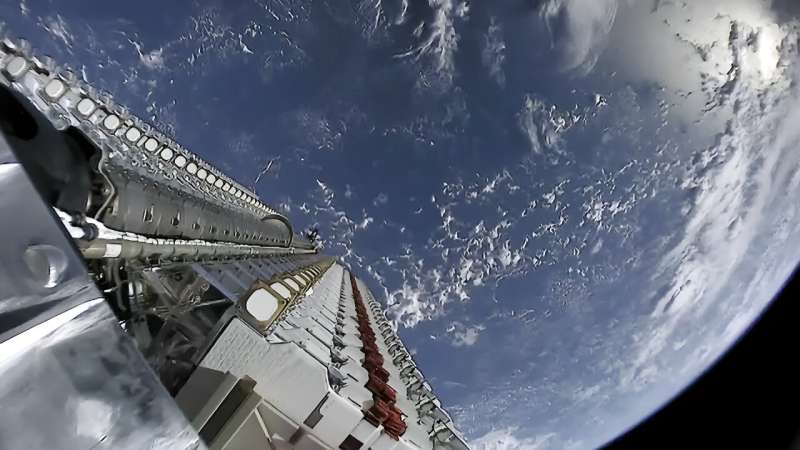
Thousands of satellites in “megaconstellations” have been launched to meet the demand for global Internet service, and thousands more will be launched in the near future. But these small satellites have a short lifespan and, when they burn up during reentry, will release ozone-depleting pollutants. A new study in Geophysical Research Letters measures this pollution for the first time. Credit: SpaceX/public domain
When old satellites fall into Earth’s atmosphere and burn up, they leave behind tiny particles of aluminum oxide, which eat away at Earth’s protective ozone layer. A new study finds that these oxides have increased 8-fold between 2016 and 2022 and will continue to accumulate as the number of satellites in low Earth orbit increases in the sky.
The study is published in the journal Geophysical Research Letters.
The 1987 Montreal Protocol successfully regulated ozone-depleting CFCs to protect the ozone layer, shrinking the ozone hole over Antarctica with recovery expected within fifty years. But the unforeseen growth of aluminum oxides could halt the ozone success story in the coming decades.
Of the 8,100 objects in low Earth orbit, 6,000 are Starlink satellites launched in recent years. The demand for global Internet coverage is driving a rapid increase in the launch of small satellite communications bundles. SpaceX is the leader in this venture, with permission to launch 12,000 more Starlink satellites and up to 42,000 planned. Amazon and other companies around the globe are also planning constellations ranging from 3,000 to 13,000 satellites, the study’s authors said.
Internet satellites in low Earth orbit are short-lived, about five years. Companies must then launch replacement satellites to maintain Internet service, continuing a cycle of planned obsolescence and unplanned pollution.
Aluminum oxides ignite chemical reactions that destroy stratospheric ozone, which protects the Earth from harmful UV radiation. The oxides do not chemically react with ozone molecules, instead causing destructive reactions between ozone and chlorine that deplete the ozone layer. Because aluminum oxides are not consumed by these chemical reactions, they can continue to destroy ozone molecule after molecule for decades as they drift through the stratosphere.
However, little attention has yet been paid to the pollutants formed when satellites fall into the upper atmosphere and burn up. Previous studies of satellite pollution focused mainly on the consequences of propelling a launch vehicle into space, such as the release of rocket fuel. The new study, by a research team from the University of Southern California’s Viterbi School of Engineering, is the first realistic assessment of the extent of this long-lived pollution in the upper atmosphere, the authors said.
“Only in the last few years have people started to think that this might become a problem,” said Joseph Wang, an astronautics researcher at the University of Southern California and corresponding author of the new study. “We were one of the first teams to look at what the implication of these facts might be.”
The threat of sleep
Because it is effectively impossible to collect data from a burning spacecraft, previous studies used analyzes of micrometeoroids to assess possible contamination. But micrometeoroids contain very little aluminum, the metal that makes up 15% to 40% of the mass of most satellites, so these estimates didn’t apply well to the new “cluster” satellites.
To get a more accurate picture of satellite reentry contamination, the researchers modeled the chemical composition and bonds within satellite materials as they interact at the molecular and atomic levels. The results gave the researchers an understanding of how the material changes with different energy inputs.
By 2022, reentry into satellites increased aluminum in the atmosphere by 29.5% above natural levels, the researchers found. Modeling showed that a typical 250-kilogram (550-pound) satellite with 30% of its mass made of aluminum will generate about 30 kilograms (66 pounds) of aluminum oxide nanoparticles (1-100 nanometers in size) during its reentry fall. . Most of these particles are created in the mesosphere, 50-85 kilometers (30-50 miles) above the Earth’s surface.
The team then calculated that based on the size of the particles, it would take up to 30 years for the aluminum oxides to descend to stratospheric heights, where 90% of Earth’s ozone resides.
The researchers estimated that by the time the planned satellite constellations are completed, 912 metric tons of aluminum (1,005 US tons) will fall to Earth each year. This will release about 360 metric tons (397 US tons) of aluminum oxide per year into the atmosphere, an increase of 646% over natural levels.
More information:
José P. Ferreira et al, Potential Ozone Depletion from Falling Satellites During Atmospheric Reentry in the Mega-Constellations Era, Geophysical Research Letters (2024). DOI: 10.1029/2024GL109280
Provided by the American Geophysical Union
citation: Satellite ‘Megaconstellations’ May Jeopardize Ozone Hole Recovery (2024, June 12) Retrieved June 13, 2024, from https://phys.org/news/2024-06-satellite-megaconstellations-jeopardize-recovery-ozone.html
This document is subject to copyright. Except for any fair agreement for study or private research purposes, no part may be reproduced without written permission. The content is provided for informational purposes only.
